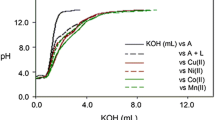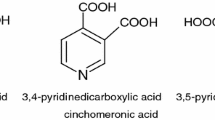Abstract
The reactions of 3-chloro-2-hydroxy-1,4-naphthoquinone; chlorolawsone with “Na” metal (ClLw-1), CH3COONa (ClLw-2), NaOH (ClLw-3), KOH (ClLw-4) and K2CO3 (ClLw-5) have been studied. Dark brown solids obtained for ClLw-1 to ClLw-5 are characterized by elemental analysis FTIR, 1HNMR, UV–Visible spectroscopy, thermogravimetric analysis and DSC studies. FTIR of ClLw-1 to ClLw-5 shows decrease in νC=O frequency after complexation of alkali metal ions and νOH of adsorbed as well as coordinated water molecules have been observed between 3,600 and 3,100 cm−1. The benzenoid protons C(5)H and C(8)H shows down field shift due to intermolecular hydrogen bonding interaction with neighboring molecules and upfield shift have been observed for C(6)H and C(7)H protons in ClLw-1 to ClLw-5 in 1HNMR spectra. Bathochromic shift ~2 to ~5 nm have been observed for band at 287 nm. The nature of pyrolytic decomposition in chlorolawsone anion in ClLw-1 to ClLw-5 has been observed to be “gradual-1–abrupt–gradual-2”. Phase transition occurred during gradual-1 pyrolytic decomposition of chlorolawsone anion in ClLw-1 to ClLw-4 has been studied by DSC.







Similar content being viewed by others
References
Siegel D, Reigan P, Ross D. One- and two-electron-mediated reduction of quinones: enzymology and toxicological implications. In: Elfarra, Adnan Ed. Advances in bioactivation research. New York: Springer; 2008. pp. 179–197.
Salunke-Gawali S, Rane SY, Boukheddaden K, Codjovi E, Linares J, Varret F, Bakare P. Thermal, magnetic and electrochemical properties of polymeric copper complexes of 2-hydroxy-1,4-naphthoquinone and its methyl derivative Ind. J. Chem. 2004;43A:2563–2567.
Todkary AV, Dalvi R, Salunke-Gawali S, Linares J, Varret F, Marrot J, Yakhmi JV, Bhadbhade M, Srinivas D, Gejji SP, Rane SY. SOM assembly of hydroxynaphthoquinone and its oxime: Polymorphic X-ray structures and EPR studies. Spectrochim Acta Part A. 2006;63:130–8.
Rane SY, Ahmed K, Salunke-Gawali S, Zaware SB, Srinivas D, Gonnade RG, Bhadbhade M. Vitamin K3 family members: single crystal X-ray structures, temperature induced packing polymorphism, magneto-structural correlations and probable anti-oncogenic candidature. J Mol Struct. 2008;892:74–83.
Salunke-Gawali S, Rane SY, Puranik VG, Guyard-Duhayon C, Varret F. Three dimensional hydrogen-bonding network in a copper complex of 2-hydroxy-1,4-naphthoquinone: structural, spectroscopic and magnetic properties. Polyhedron. 2004;23:2541–7.
Rane SY, Gawali SD, Padhye SB, Kumbhar AS, Bakare PP. Thermal studies of metal-quinone complexes. Role of aqua coligations with copper(II) in coordination of 2-hydroxy-1,4-naphthoquinone. J Therm Anal Calorim. 1999;55:249–58.
Salunke-Gawali S, Dalvi R, Khursheed A, Rane SY. Thermal, magnetic and spectral studies of metal-quinone complexes part II. Media effect on colligation of aqua ligands. J Therm Anal Calorim. 2004;76:801–12.
Salunke-Gawali S, Rane SY, Boukheddaden K, Codjovi E, Linares J, Varret F, Bakare PP. Thermal, magnetic and spectral studies of metal-quinone complexes part III. Radical coordination and hydrogen bonding mediated exchange interaction in copper-hydroxyquinone complex. J Therm Anal Calorim. 2005;79:669–75.
Jiang C-H, Song L-F, Jiao C-Li, Zhang J, Sun L-X, Xu F, Cao Z. Exceptional thermal stability and thermodynamic properties of lithium based metal–organic framework. J Therm Anal Calorim. 2011;103:373–80.
Song L-F, Jiao C-Li, Jiang C-H, Zhang J, Sun L-X, Xu F, Jiao Q-Z, Xing Y-H, Huang FL, Du Y, Cao Li F, Zhao J. Heat capacities and thermodynamic properties of MgNDC. J Therm Anal Calorim. 2011;103:365–72.
Armarego WL, Perrin DD, Perrin DR. Purification of laboratory chemicals. London: Pergamon Press; 1998. 260.
Conant JB, Fieser LF. Reduction potentials of quinones. II. The potentials of certain derivatives of benzoquinone, naphthoquinone and anthraquinone. J Am Chem Soc. 1924;46:1858–81.
Joela H, Lehtovuori P. EPR, ENDOR, TRIPLE resonance spectroscopy and MO studies on radical anion, neutral radical and radical cation of vitamin K3 in a selection of solvents. Phys Chem Chem Phys. 1999;1:4003–10.
Roginsky VA, Pisarenko LM, Bors W, Michel C. The kinetics and thermodynamics of quinone-semiquinone-hydroquinone systems under physiological conditions. J Chem Soc Perkin Trans. 1999;2:871–6.
Salunke-Gawali S, Kathawate L, Shinde Y, Puranik VG, Weyhermüller T. Single crystal X-ray structure of Lawsone anion: evidence for coordination of alkali metal ions and formation of naphthosemiquinone radical in basic media. J Mol Struct. 2012;1010:38–45.
Satoh T, Tsuji T, Matsuda H, Sudoh S. DFT calculations and IR studies on 2-hydroxy-1,4-naphthoquinone and its 3-substituted derivatives. Bull Chem Soc Jpn. 2007;80:321–3.
Prabhumirashi LS, Kelkar VD, Jose CI. Infrared spectral study of intramolecular interactions in lawsone, juglone and their 3-halo derivatives. Ind J Phys B. 1984;58:570–82.
Padhye SB, Joshi CR, Kulkarni BA. Studies of some rare earth chelates of naphthoquinone-none antibacterials. J Inorg Nucl Chem. 1977;39:1289.
Yamada K, Yagishita S, Tanaka H, Tohyama K, Adachi K, Kaizaki S, Kumagai H, Inoue K, Kitaura R, Chang HC, Kitagawa S, Kawata S. Metal-complex assemblies constructed from the flexible hinge-like ligand H2bhnq: structural versatility and dynamic behavior in the solid state. Chem Eur J. 2004;10:2647–60.
Zaware SB, Dagade-Waghmode S, Gonnade RG, Srinivas D, Rane SY. Magnetic phase transition in valence tautomers as polymorphs of 3-iodolawsone: single crystal X-ray structure, DSC and EPR studies. J Mol Struct. 2009;938:328–35.
Acknowledgements
LK acknowledges to Department of Science and Technology (DST) for Junior Research Fellowship and SSG grateful to DST, New Delhi for Young Scientist Scheme for financial support Ref. No. SR/FT/CS-030/2009).
Author information
Authors and Affiliations
Corresponding author
Rights and permissions
About this article
Cite this article
Kathawate, L., Shinde, Y., Yadav, R. et al. Thermal, magnetic and spectral properties of metal quinone complexes. J Therm Anal Calorim 111, 1003–1011 (2013). https://doi.org/10.1007/s10973-012-2378-3
Received:
Accepted:
Published:
Issue Date:
DOI: https://doi.org/10.1007/s10973-012-2378-3




